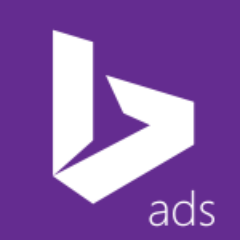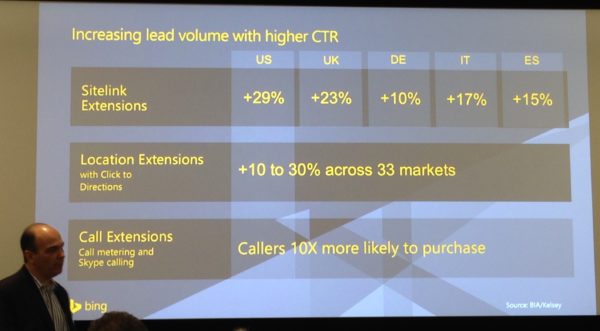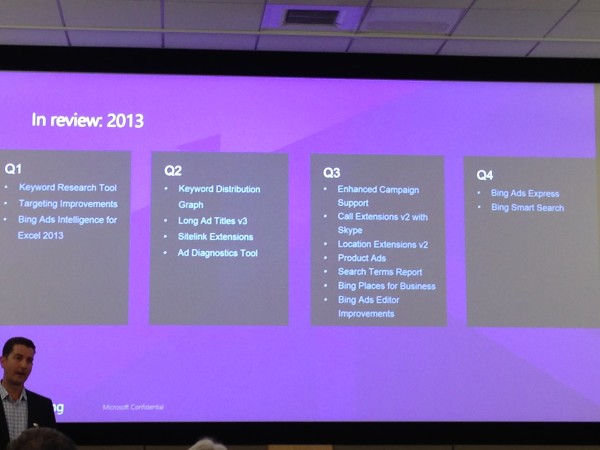Bing Ads Executives Share Plans To Make Bing A Better Ad Platform
Earlier this year, there were questions about where Bing would stand after CEO Steve Ballmer unveiled Microsoft’s reorganization plan in July. It turns out the move has been a good one for the search engine. Microsoft chose to give Bing an enterprise-wide embrace. The company is now integrating search into nearly every Microsoft device including […]

This integration “gives us the opportunity to expose Bing to billions of users across Microsoft to bring scale — not in tens of millions or hundreds of millions but in billions,” said David Pann, GM of Search Business at Microsoft, to a group of roughly 20 ad executives and members of the press at an event called Bing Ads Next held in Redmond last week.
During the event, senior members of the Bing search teams transparently discussed lessons learned, current realities and the road map for growth in 2014.
There was no sugar coating Bing’s number two place in the market. Pann said of the roadshow his team took to get feedback from Bing customers and partners, “It was pretty eye opening.”
Not surprisingly, scale was the top request from customers and partners. Next was a return on time spent. “We are very pragmatic about being number two, and we know we need to make it easy to synch campaigns with Google AdWords,” acknowledged Pann. (Thus, Bing Ads’ scramble to accommodate Google’s switch to enhanced campaigns.) Advertisers also requested better tools, and they wanted to see more frequent feature launches and improvements.
After several stagnant years, there has been a flurry of activity to make Bing Ads a better platform in the past 12 months. The platform has seen more than 20 percent advertising growth each quarter in 2013. Along with a change in its broad match serving, ad extensions are helping to drive more volume to advertisers. Pann shared click-through rate increases the company has seen with the introduction of sitelink, location and call extensions.
Bing Ads
Still, Google dominates advertiser search budgets by a long shot, and there are still weaknesses in the Bing Ads platform.
“We are not done by any means. We are at the tip of the iceberg in terms of what we need to do,” stated Pann. “We will continue to focus on transparency and focus on return on time spent. We understand that we have to help advertisers be successful in our marketplace. Advertisers aren’t going to go hunting, we need to spoon feed them on how Bing Ads works and how it can be successful. We know we might get 15 minutes of every hour spent on AdWords management, and we have to eliminate friction for advertisers.”
Smart Search
While the integration of Bing throughout Microsoft devices offers great scale, it also highlights a potential weakness that was felt during the Bing Ads Next event. Microsoft executives spent a significant amount of time touting the features of Smart Search — Bing’s search functionality on the Windows 8.1 operating system — and the huge new Hero Ads being piloted for branded queries on Smart Search. Yet, when the group at Bing Ads Next was asked how many had used Windows 8.1, maybe two hands went up.
Smart Search is not platform agnostic; it is designed for Windows 8.1 devices. If you’re on Windows 7, no Smart Search. If you use iOS devices, no Smart Search. If you use an Android device, no Smart Search. There are interesting visualizations and features of Smart Search that make Windows 8.1 a stronger OS, but the bulk of Bing search activity, and ad revenue, comes from the Yahoo Bing network, not devices running Windows 8.1. At least, for the foreseeable future.
Adam Sohn, GM, Communications, did show compelling ways in which the company is focusing on delivering richer, more engaging Bing SERPs with a query for “what’s the Tom Cruise movie with a unicorn?” I’ll let you compare the Bing results and Google results for yourself, but in this case Bing offers an entity-rich result. News and local search results are a different story, and areas where Google is leaps ahead. Sohn says Microsoft is building an “intelligent fabric” to handle entities and actions for people, places and things with geospatial and context considerations.
“The information you need should be available wherever you are and whatever device you’re using. That’s a radically different approach than a white box that you type something into. Search stops becoming this monolithic thing and starts becoming a representation of human knowledge and machine knowledge. So the things we’re paying attention to now are not websites, its entities — and the connections between those things and the actions you can take against those things”
The irony here is that with Smart Search is that it doesn’t matter what device you’re using, as long as it’s a Microsoft device. While Bing’s integration into Microsoft products means more reach, more resources, more investment, it could also prove to be its Achilles heel if the integration causes teams to being too inward focused and self-referential. Remember just two attendees had used Windows 8.1 (two!), and yet, most Bing Ads Next presentations were Smart Search-centric. Hitching Smart Search to Windows 8.1, now means that the operating system has to be widely adopted for Smart Search to take off. The Bing Ads team can’t lose sight of how the majority of users interact with Bing.
Bing Ads Simplification
There are still basic-level issues to address on Bing Ads: conversion tracking implementation and reporting has to be improved; an editor for Mac is a no-brainer; multi-account management needs be simplified. These are apparently in the works, but they’ve been on the punch list for ages. Brian Utter, GM, Network and Demand, said the company executed 104 updates to the platform in the past year, a marked improvement from years past. “We have a long ways to go, but we feel very good at where we’ve gone in a very short time,” he stated.
Search Ads & Social
When the question about social integration with ads came up — specifically for Hero Ads, but also more generally in light of Google’s recent move to include Google+ user content in ads — the answer was blunt: “We haven’t figured it out yet.”
This was interesting considering Bing’s partnerships with Facebook and Twitter to show social streams in the SERPs. The message was echoed by both David Pann and Eric Boyd, GM Paid Search Development at Microsoft. Pann said they have constant discussions with Facebook and Twitter and “we will keep working with them to figure out where it makes sense, but for now, Smart Search relies on Microsoft’s own data.”
Part of the concern is privacy, said Pann, but Boyd said the other issue is they haven’t “found that answer yet that shows it moves the needle” for advertisers. For now, Bing will focus their efforts on areas they know will provide better ROI and reduce friction for advertisers using the platform.
Leveraging Microsoft Properties & Partnerships
Microsoft is finally bringing the benefits of its properties and partnerships to Bing. Excel is now integrated into Bing Ads reporting capabilities, Skype powers Bing Ads call extensions and Bing Ads Express leverages the partnership with Facebook.
The Bing Ads team is redoubling its outreach efforts, but the company still misses out on communicating these details that make its offerings stand apart from Google. The Skype functionality of call extensions means they can be used across all devices, not just on smartphones. That’s a big differentiator that needs to be shouted, repeatedly, to advertisers and users. Likewise, the new Bing Ads Express program allows small businesses to tie their ads to their Facebook pages, again a huge potential benefit to many advertisers that should be conveyed loudly, beyond a blog post.
Paul Apodaca, Director of Engineering and Planning, discussed Bing Ads plans for 2014. We were asked not to share details yet, but I can say that there is attention being paid to the punch list, there will be a bigger focus on providing advertisers with richer data to make informed decisions, and new ad features and tools are in the works.
The plans do underscore GM, Product Marketing, Steve Sirich’s opening remarks that, “Microsoft is going through a transformational process and Bing is certainly an anchor of the change.” Smart Search will be interesting to watch evolve. Bing Ads will be available to be in 55 countries by the end of 2014. Rik van der Kooi, chief operating officer of Microsoft’s Applications and Services said the Yahoo Bing partnership remains strong, despite rumors to the contrary. Product ads should roll out of beta next year, which should raise retailer interest. It’s a steep climb ahead, but the answer to whether Microsoft is truly committed to search and to Bing Ads appears to be yes.
Opinions expressed in this article are those of the guest author and not necessarily Search Engine Land. Staff authors are listed here.
Related stories
New on Search Engine Land

